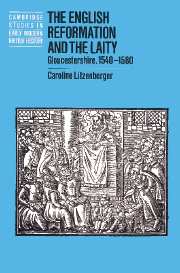Book contents
- Frontmatter
- Contents
- List of figures
- List of tables
- Acknowledgments
- Abbreviations and conventions
- Introduction
- 1 Setting the scene
- 2 Gloucestershire in the 1530s
- 3 The new diocese of Gloucester (1540–1546)
- 4 The advent of Edwardian Protestantism (1547–1553)
- 5 A return to the old religion (1553–1558)
- 6 The early years of Elizabeth's reign (1559–1569)
- 7 The clarification of the religious settlement (1570–1580)
- Conclusion
- Appendix A Sources and methodology
- Appendix B Results of wills analysis
- Appendix C Parish finances
- Bibliography
- Index
- Cambridge Studies in Early Modern British History
2 - Gloucestershire in the 1530s
Published online by Cambridge University Press: 23 November 2009
- Frontmatter
- Contents
- List of figures
- List of tables
- Acknowledgments
- Abbreviations and conventions
- Introduction
- 1 Setting the scene
- 2 Gloucestershire in the 1530s
- 3 The new diocese of Gloucester (1540–1546)
- 4 The advent of Edwardian Protestantism (1547–1553)
- 5 A return to the old religion (1553–1558)
- 6 The early years of Elizabeth's reign (1559–1569)
- 7 The clarification of the religious settlement (1570–1580)
- Conclusion
- Appendix A Sources and methodology
- Appendix B Results of wills analysis
- Appendix C Parish finances
- Bibliography
- Index
- Cambridge Studies in Early Modern British History
Summary
Prior to the founding of the new diocese in 1541, Gloucestershire was marked by the same religious ambivalence that characterised much of the rest of England. On the one hand, there is considerable evidence of the vigour of traditional lay piety among both the elite and the ordinary people. Support for the re-building and re-decoration of local parish churches was continuing and even increasing, and acts of lay piety such as pilgrimages to the Blood of Hailes continued to be popular. On the other hand, there were also signs of the promotion and acceptance of the new religion in public pulpits and private households, as the theological issues which distinguished Protestantism from traditional religion were presented and discussed by all types and conditions of men and women. There were isolated instances of anticlericalism, but for the most part the presentation of the new religion was more positive than that, focusing on issues of faith and doctrine. In Devon and Cornwall, Protestant support may have been motivated primarily by secular concerns, but such was not the case in Gloucestershire. Furthermore, traditional lay piety in that county, as in other areas of England, was thriving. Support for the new religion, while based on theological concerns, was still extremely fragmented and represented a very small proportion of the county's inhabitants. In addition, that percentage would decrease over the next few decades.
The rebuilding of Cotswold churches in the perpendicular style offers convincing evidence of the continued vitality of the pre-Reformation church in England. The assertion that the Protestant Reformation was both welcomed and needed because the late-medieval church had fallen into decay and disrepute among ordinary lay people has been thoroughly laid to rest by a number of historians, and Gloucestershire provides further evidence of this.
- Type
- Chapter
- Information
- The English Reformation and the LaityGloucestershire, 1540–1580, pp. 23 - 43Publisher: Cambridge University PressPrint publication year: 1997



